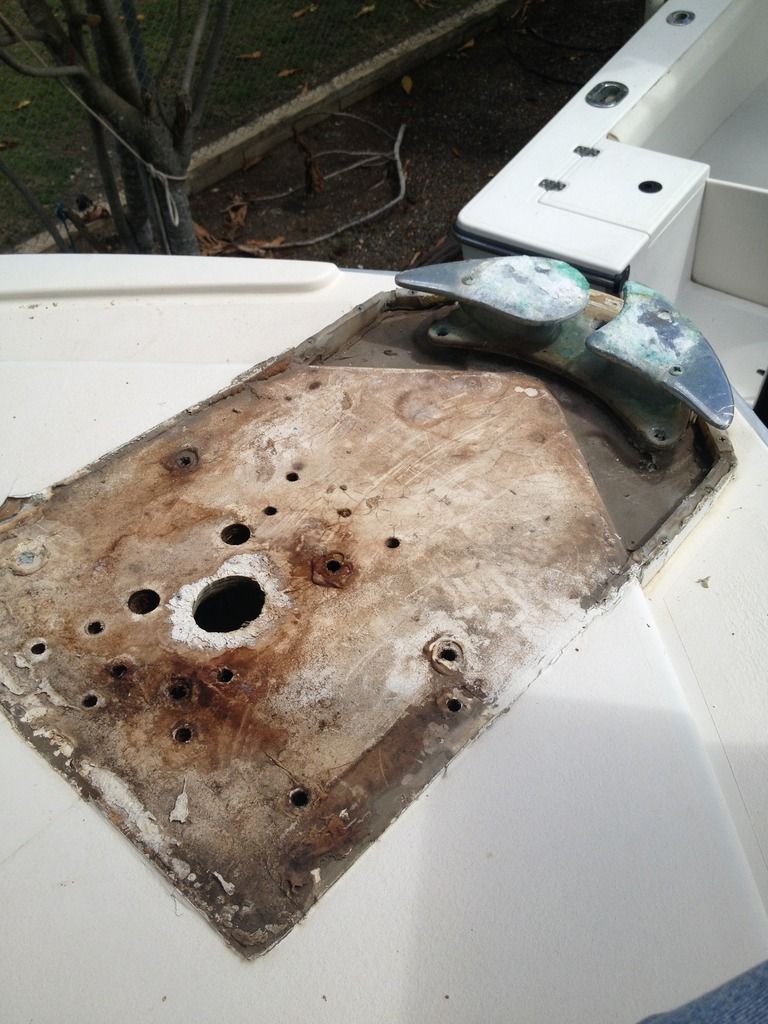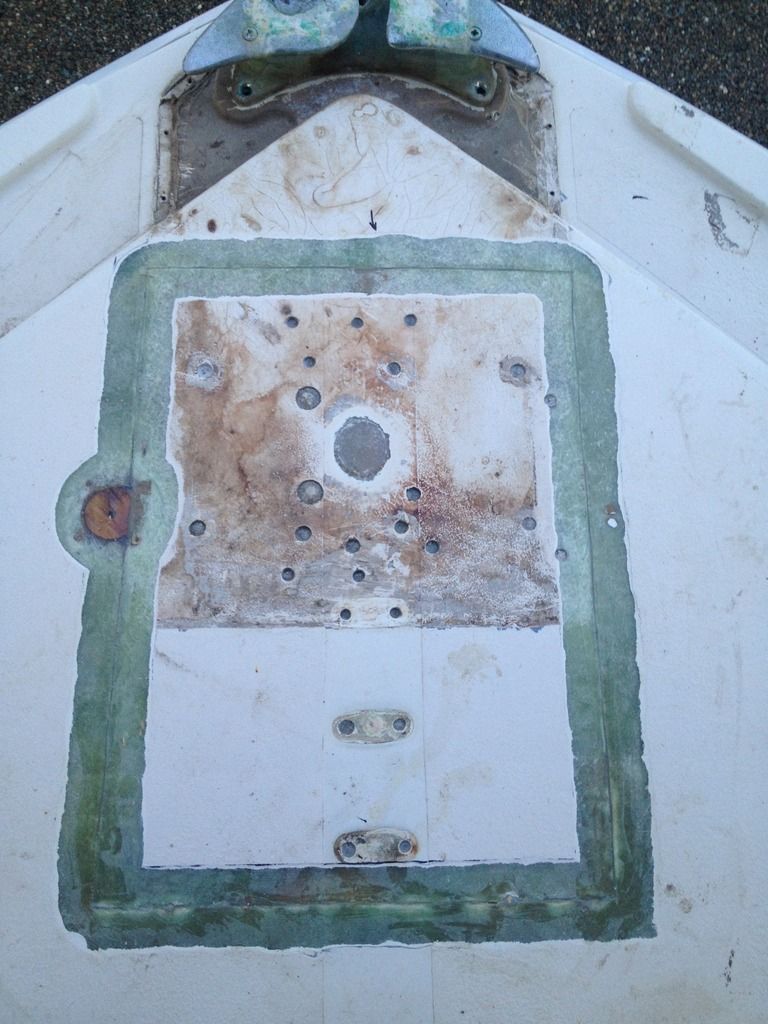Got a few soft spots on the deck (bow) on my 28 FB. Am thinking about drilling & injecting epoxy, OR, does anyone have a better idea.
I am not crazy about tearing out the v-berth headliner, but if I have to I will.
Comments, suggestions ?
Lawrence Thornton
1973 28fb
Soft Spot on 28 FB bow deck.
Moderators: CaptPatrick, mike ohlstein, Bruce
-
Tony Meola
- Senior Member
- Posts: 7036
- Joined: Jun 29th, '06, 21:24
- Location: Hillsdale, New Jersey
- Contact:
Re: Soft Spot on 28 FB bow deck.
Not Shure that will work. Don't know on the 28 but on my 31 I can see the bottom side of the deck from the rope locker. You might be able to tell from there without ripping down any overhead.
1975 FBC BERG1467-315
Re: Soft Spot on 28 FB bow deck.
Lawrence,
I recently drilled new cleat holes on my '73 28 deck and...verified that it's a glass sandwich alright!
If it is the same wood core as in the bathroom sole (which I also removed a part of, to create a shower) then this intermediate wood is balsa.
Unless there is a crack on your deck, the culprit for water intrusion may be the hatch, the anchor windlass or anchor chain hole and the cleat screw holes. If you have anchor securing fasteners, those too. I would start from checking which of all is more probable.
What Tony sees, is probably the same in the 28, in that you can see the bottom of the deck by sticking your head into the anchor locker, only what you see there is not the balsa but the under layer of glass; I wonder if this can be of any significant use, as your problem lies over that glass layer.
If your problem lies just in the gunnels area, then you don't have to remove the roof liner, just (depending on how your boat is made) remove the wood that secures the top part of the side "fleece like" liner, and you're just under the gunnels.
Lets see how others treated this problem.
Good luck.
I recently drilled new cleat holes on my '73 28 deck and...verified that it's a glass sandwich alright!
If it is the same wood core as in the bathroom sole (which I also removed a part of, to create a shower) then this intermediate wood is balsa.
Unless there is a crack on your deck, the culprit for water intrusion may be the hatch, the anchor windlass or anchor chain hole and the cleat screw holes. If you have anchor securing fasteners, those too. I would start from checking which of all is more probable.
What Tony sees, is probably the same in the 28, in that you can see the bottom of the deck by sticking your head into the anchor locker, only what you see there is not the balsa but the under layer of glass; I wonder if this can be of any significant use, as your problem lies over that glass layer.
If your problem lies just in the gunnels area, then you don't have to remove the roof liner, just (depending on how your boat is made) remove the wood that secures the top part of the side "fleece like" liner, and you're just under the gunnels.
Lets see how others treated this problem.
Good luck.
1973 B28 FBC/2007 4LHA STP's - "Phantom Duck" - Hull "BER 00794 1172"
-
Howesounder
Re: Soft Spot on 28 FB bow deck.
I had a soft deck on the starboard bow of a 63, 25 express. Tried the injection method on a bayliner 4588 with marginally acceptable results. On the Bertram, I removed the headliner like you are rightfully dreading. Found fibreglass honeycomb on the port side, and balsa core on the failed starboard side. Because of the hit and miss nature of the rott in the balsa, I suspect that epoxy injection would have been unsuccessful. We just removed the balsa, and layed up a bunch more woven roving and matt on the starboard side. Seems to have worked very well. Foam board to take up the space, and put the headliner (fg) back.
Steve
Steve
Re: Soft Spot on 28 FB bow deck.
Lawrence,
I had to repair the deck area where the windlass was installed because it was soft. I had a bow pulpit which covered most of this area but when it was removed, i found out that it had a bunch of old holes that weren't correctly sealed. So I did the following:
1) Cut the top skin and removed as carefully as possible so it could be reused. I had to add a layer of FG to reinforce it once I ground out all the weak spots.
2) Removed all the rotten wood in the area, being careful no t damage the lower skin. In the B28 they used marine ply in this area where the windlass and cleats are installed. After that, its all balsa core.
3) Installed new marine plywood by cutting it to size and bedding with epoxy/cabosil. I had to score the plywood longitudinally so it could achieve the deck crown.
4) Glued the top skin back with epoxy/cabosil mix and weight on top.
5) Ground out all the seams to green fiberglass and laminated a thin strip all around, to bind the cutout with the existing deck FG. Once dry, sanded everything down and applied fairing compound.... followed by moree sanding.
Here are some pics:
what I found when removed the pulpit..

This is after removing the rotten wood and gluing the top skin back in place...

Finished product after glassing the seams/holes and sanding.

Hope this helps. If you have any questions, let me know.
Regards,
G
I had to repair the deck area where the windlass was installed because it was soft. I had a bow pulpit which covered most of this area but when it was removed, i found out that it had a bunch of old holes that weren't correctly sealed. So I did the following:
1) Cut the top skin and removed as carefully as possible so it could be reused. I had to add a layer of FG to reinforce it once I ground out all the weak spots.
2) Removed all the rotten wood in the area, being careful no t damage the lower skin. In the B28 they used marine ply in this area where the windlass and cleats are installed. After that, its all balsa core.
3) Installed new marine plywood by cutting it to size and bedding with epoxy/cabosil. I had to score the plywood longitudinally so it could achieve the deck crown.
4) Glued the top skin back with epoxy/cabosil mix and weight on top.
5) Ground out all the seams to green fiberglass and laminated a thin strip all around, to bind the cutout with the existing deck FG. Once dry, sanded everything down and applied fairing compound.... followed by moree sanding.
Here are some pics:
what I found when removed the pulpit..

This is after removing the rotten wood and gluing the top skin back in place...

Finished product after glassing the seams/holes and sanding.

Hope this helps. If you have any questions, let me know.
Regards,
G
Jorge E.
1973 Bertram 28'
Yanmar 4LH-STE's
1973 Bertram 28'
Yanmar 4LH-STE's
Who is online
Users browsing this forum: Google [Bot] and 166 guests